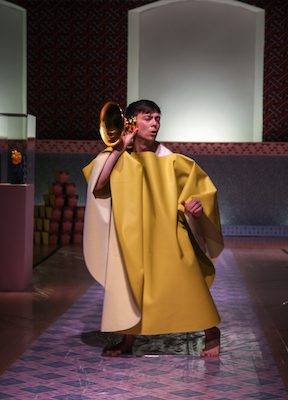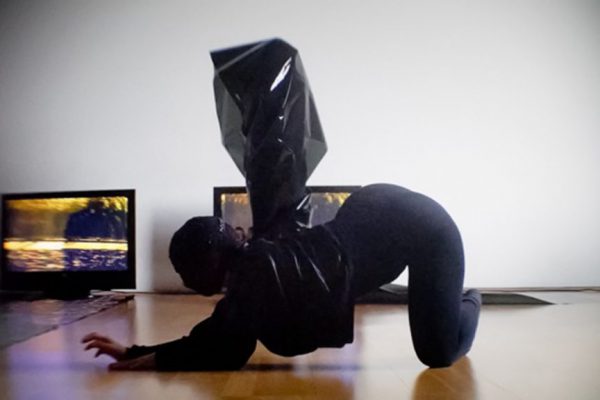When you let other choreographers remix your work, radical shifts can result, bringing into question cultural practice. Case in point is Danse Mutante, which began as a duet entitled Cantique, created by Montréal-based choreographer Mélanie Demers (MAYDAY). With a cast of two, Francis Ducharme and Riley Sims, Cantique expanded when Demers invited three other choreographers — Ann Liv Young (New York), Kettly Noël (Bamako) and Ann Van den Broek (Antwerp/Rotterdam) — into the project, to take on Demers’ choreography and make it their own. The essence of this choreographic relay saw Young remix Demers’ version, Noël remix Young’s version, and Van den Broek remix Noëls version.
A few parameters were set: the two performers remained the same, and there would be a limited creation period and a specific length for the piece. Each choreographer was mailed, to their respective continents, a suitcase filled with material from previous iterations and given the freedom to create and strip the version they received to their heart’s content. Danse Mutante reveals these reinterpretations as a stirring and sometimes quizzical assortment. Extending over two and a half hours, apart from a twenty-minute intermission, the interpreters are onstage for the entire time of this mini-event. The result is arresting, transgressive and operatic.
Demers’ original duet, a pared-down study, places its emphasis on simplicity: the dancers perform on a bare white stage floor, in white briefs and socks and white knee pads, occasionally wrapping themselves in simple taupe-striped blankets, cans of soda water in hand, which they shake to excess. In the cool white lighting design, spoken word in French and English is delivered with phrasing that demands attention, the text rippling with a catalogue of identifiers that may or may not stick — queer, able-bodied, boy next door, and on it goes. We’re witness to the evolving relationship between the two, their bodies and worlds — first separate and then entwined.
Cantique is probably the most sustained piece of performance that I’ve seen from Demers. She’s normally got an inclination towards ramped-up, high-pitched performance, with quite a bit of shouting, and less a need to create nuanced work, at least to my eye. She often misses the emotional connection waiting to be explored in a piece. Here, she’s in unexpectedly subtle mode and responds to her ideas with simpler choices, never forcing the audience to be needlessly mindful of the theatricality of the situation.
As an interpreter Ducharme has previously acquiesced to self-aware indulgences, never fully embracing the very physical, visceral possibilities of the moment. For years, I’ve been hoping someone would direct him to a confident, all-in honest performance, and finally it is Demers who has given him a platform to be at his most natural, working with spontaneity in the best way. Sims was unknown to me, and I entered uncertain of what to expect of the duo together in this marathon performance. The Toronto-based dancer and choreographer is the real thing, searing and passionate in his singing, dancing, speaking, awakening thrilling new realities within his characters and settling effortlessly in each new role throughout the work.
It’s fascinating to see Ann Liv Young’s care for the craft-making (she makes the craft disappear). But her work was the most unsettling. She is onstage, to the side, notebook and cellphone in hand, live-directing Sims and Ducharme, who appear in Sally Ann dresses and wild wigs. Her tone is volcanic, abrasive, and yet she’s specific with language, pushing the performers verbally, stopping them in their tracks and guiding them for more authenticity in their improvisations. She pulls them back from what she terms “too much,” stripping their agitation and allowing them to settle into a calm state. Then, prompting them with “Are you certain you can do this?” or “Why are you doing this?” or “Drop the character, be neutral,” she gets them, through her interventions, to be their best.
In the most charged scene of the evening, Sims plays a wrestling coach, and Ducharme a young girl who is mute — a choice that in my mind seemed exploitative. The tension rises as the coach begins to abuse the young gymnast, culminating in a rape. When the performers choose to stop the scene, Young reels them back in, demanding they do it again. “These people have to understand this is rape,” she proclaims, referring to the audience. And again the scene unfolds, with the performers going further into the physicality and the emotions, this time with aching, painful reality. The tension in the theatre was palpable.
Noël, a Haitian-born artist based in Bamako, Mali, instills her section with a tone of utter languor. The tender, nurturing scene opens with Ducharme softly brushing Sims’ hair and the two whispering in sultry intimacy, their shadows writ large on the side wall of the stage. Incense permeates the immersive space. Shortly afterwards, Ducharme paints Sims’ toes and then Sims etches his finger along his partner’s back, as we hear the tapping of a stone and the soft lilts of a male singing, most likely in Bambara, the lingua franca of the country.
The languid movement and the amber lighting, all suggestive of the heavy tropical climate of the savannah in the south, are calming and enticing, and yet this is a subversive confabulation, an upside-down world in opposition to the current realities plaguing that corner of the world. Noël next shifts to a different passage revealing the harsh realities of dysfunctional life in Mali, with Sims portraying a toxic white Canadian male visitor seducing a local woman (Ducharme), claiming to “own” her and treating her literally as a dog. The scene, however, remains a colonialist stereotype of its own, undercutting her critical reflection.
In the final tableau, by Van den Broek, the set is stark, with minimalist lighting and the performers in simple, stylish black shirts and pants. As they stand in front of microphones, their breath and their singing voices are sampled, their looped sounds and rhythms fracturing repeatedly. Ducharme and Sims gesticulate, their fingers and arms thrusting mechanically forward, repeatedly, building aggressively, as we sense the performers’ exhaustion and see their sweat fly. Towards the end, they slowly, captivatingly, weave one in front of the other. But by then, this chapter has overstayed its welcome.
With Danse Mutante, the four choreographers are embracing an art practice that struggles to change the social contract and are mediating their experience of the world. They are shifting stigmas and forging powerful channels of communication. What they’re stirring up, with different levels of achievement, is the uniqueness and the individuality of art.
Tagged: Contemporary, Mélanie Demers, Riley Sims, QC





